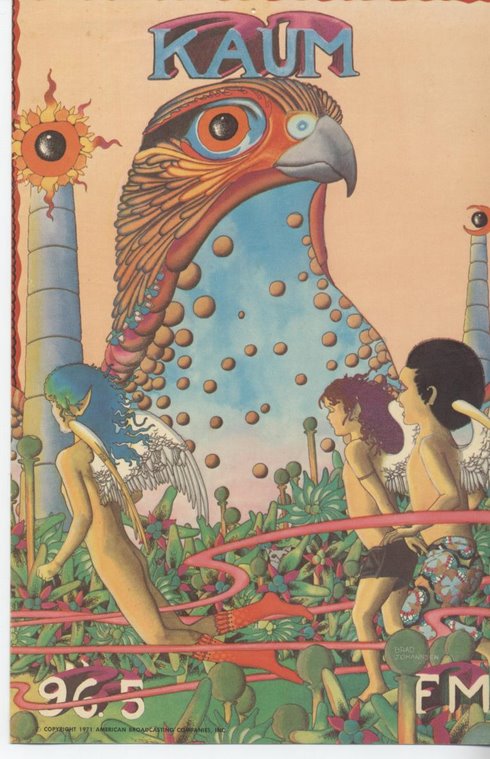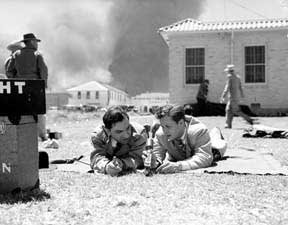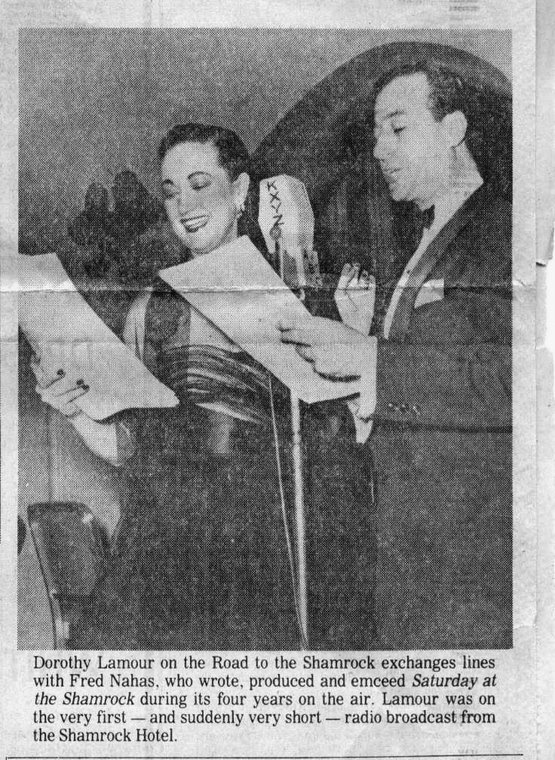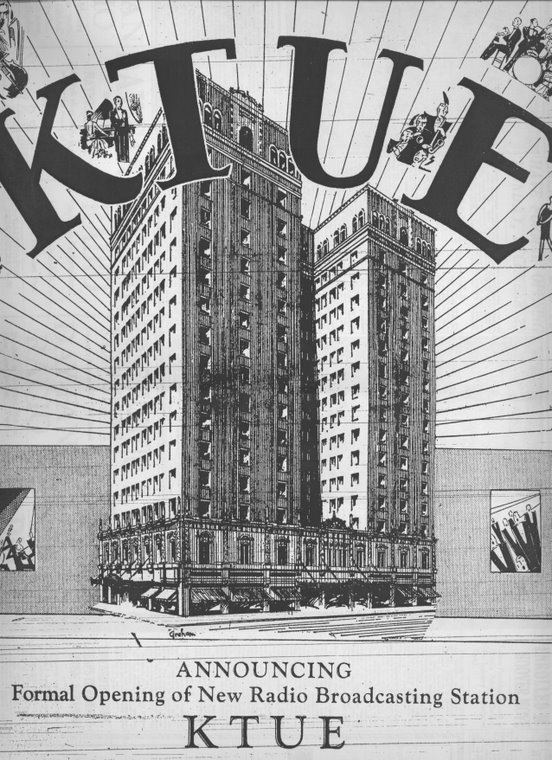1929 Part 1 - K-The Rice Hotel
There were no new stations authorized in the Houston-Galveston area in 1929 but in Austin and San Antonio there were developments which were to affect the Houston radio dial.
Over the years, radio stations had gotten more expensive to operate and the government had exercised more control over broadcasters. The University of Texas had participated in wireless activities as early as 1911 when engineers at the Agricultural and Mechanical College of Texas at College Station originated a wireless message. Both schools had been supplied with equipment and the broadcast was intended to originate a network to include institutions of higher education in the state. The University held the license for Austin’s first radio station (and 2nd in the state), WCM, issued March 22, 1922, one day before the license for WEV was issued to the Hurlburt-Still Co. In Houston. When WCM left the air in October, 1925, it was licensed to the Texas Department of Warehouses and Markets and UT put another station on the air with the call letters KUT. But after the government ordered the use of crystal control by broadcasters in 1927, the University decided to get out of broadcasting. According to historian Richard Shroeder, by February, 1929, KUT had been sold to two brothers from Houston whose last name was English and they moved the station from the Driskill Hotel in downtown Austin to a golf course on the Georgetown-Fiskville Rd. Then they went bankrupt in just a few months.
That same month KUT was sold, ownership of San Antonio radio station KGDR was transferred from it’s original owner, Joe B. McShane, to the KGDR Broadcasting Co.; it operated from the Blue Bonnet Hotel.
-
In 1929 you could rent a room at Jesse Jones’ Rice Hotel in Houston for $2.50 cents a night. The ‘Top o’ Houston’ Rice Roof Garden promised the end of a perfect day, ‘an ever refreshing haven of pleasure and evening recreation,’ sixteen floors above the clamor and heat of the city streets. Table d’Hote Dinners were $1.50 Sundays, $1.25 weekdays and while you enjoyed your dinner a 10 piece orchestra entertained. Reservations were recommended. Besides dining and dancing and deluxe accomodations, by late that year the Rice was getting into broadcasting, buying and then moving 2 radio stations, putting one out of business while starting another.
In November, ownership of KGDR, San Antonio, was transferred again to the Milam Radio Co. and then on December 9, ownership transferred yet again to the Rice Hotel of Houston which then received approval from the Commerce Department to change the call letters to KUT and move the station to Austin. At the same time the Rice Hotel also bought the station that had been operating in Austin as KUT and received approval to change it’s call letters to KTRH and move it to Houston. The Federal Radio Commission had agreed to let KUT be moved to Houston only if a replacement station was put on the air in Austin which otherwise would have been without a station.
According to the station’s history posted on the KTRH website in 2005 for the station’s 75th anniversary as a Houston station, Jesse Jones bought KUT in Austin and moved it to Houston in the back of a pick up truck to become KTRH. KGDR was moved to Austin and commenced to operate as KUT, on a different frequency and with less power than the previous station with those calls. It was apparently the 1000 watt KUT transmitter than Jones wanted for Houston; otherwise he could have just moved KGDR here. The Rice Hotel continued to hold the license for KUT and operate it until 1932 when it sold the station to Hearst Publications and the call letters were changed to KNOW.
That pick-up truck must have put on a lot of miles that winter.
The Chronicle announced the developments in a brief story on page 1 of the December 11 edition. The transmitter building and towers were being erected on the La Porte highway at Deepwater and it was anticipated the station would be on the air by late February or early March. A ‘1000 watt transmitter has been acquired;’ the call letters KTRH were to stand for K - The Rice Hotel. The story also mentioned that KUT had been off the air since it’s owners had gone into receivership and the Federal Radio Commission had ordered that KUT was to continue operation. The fact that KGDR was going off the air was also mentioned.
Depending on your interpretation of these events, either KNOW, Austin, (now known as KFON, a Spanish station at 1490) or KTRH, Houston, is the descendant of University of Texas radio station KUT. The Broadcasting Yearbook credits KFON as having originated in 1922 (as WCM) and gives the date of origin of KTRH as March 29, 1930. The current owners of KTRH, Clear Channel Communications, seem to be satisfied with the 1930 date but Thomas White's US Early Radio History credits KTRH as the true heir of WCM and names it the 35th oldest radio station in the US. Barry Mishkind’s Broadcast Archive offers the same analysis and if you subscribe to this view, KTRH is also the 2nd oldest radio station in Texas though only the 4th oldest radio station in the Houston/Galveston market.
As mentioned in the section of this chronology on the year 1925, the Commerce Department records I have seen do not support the claim that KUT was a continuation of WCM. They show that KUT was authorized in October, 1925, as a new station with different ownership than WCM, not just a change of call letters and ownership. However I have not seen the original files of the station’s license, only a summary report as published by the Commerce Department monthly. KFON can trace its history to the original license for KGDR in December, 1926; neither KFON nor KTRH can claim its origin in 1922 according to what I have seen.
UPDATE: NEW INFORMATION HAS BEEN RECEIVED CONCERNING THE SOMEWHAT COMPLICATED HISTORY OF WCM/KUT/KTRH AND A SEPARATE ARTICLE HAS BEEN PUBLISHED TRYING TO SORT IT ALL OUT.
Having spent 40 years in radio, all of it either on the air or in the program director’s chair, I have come to consider a radio station to be part and parcel of the community it operates in and the idea that a radio station can be picked up and moved 200 miles to another city and still be the same radio station, even if it operates with exactly the same equipment and call letters, just doesn’t ring true to me, and in this case there was a change of ownership, change of city, and change of call letters involved, not to mention the fact the station had to have been off the air for some time during the move. But in fact there are several notable examples in the history of broadcasting of just such moves; apparently the issue is the continuity of license, regardless of owners, call letters or city of license.
There will be more on KTRH in the section of this chronology on the year 1930.










4 comments:
I remember going to Houston's Rice Hotel many times with my grandmother, for lunch. We stopped by the studios of KTRH to watch through the glass as broadcasters like Pat Flaherty reported the news. I was fascinated with all the lights, equipment, microphones, and all in the studios and with being able to hear the broadcasts on the speakers in the hotel hallway. My grandmother had to tear me away everytime we went, because I did not want to leave. When I was 15, I had my own show on KULP radio in El Campo, TX, a Houston suburb, and later went on to become the 1st FCC licensed female anncr. in Dallas Radio - KVIL FM's Girl Named Sam in late 1964. TV Radio Mirror magazine ran a two-page feature story on my broadcasting career in Oct. '65. I've worked at McClendon's KLIF and one of the first Internet Radio Networks, Real Talk Network, in 2000. Thanks for doing this history. I've been a fan since the late forties. One of my biggest thrills came when Mr. Flaherty stepped out of the studio into the hallway to meet and talk with me - his devoted young fan. He was very kind and had a deep, beautiful 'radio voice' I liked. - Mary "SAM' Stoddard
Thanks so much for your comment, Mary. You have a lot of good stories to tell.
I never knew Pat Flaherty worked for KTRH, I only knew of him from his long association with KPRC.
I could be mistaken about the call letters for the station in the hotel. I was probably not even a teen the first time I went there. My grandmother would take me shopping and then to the hotel for a fancy lunch. Her favorite part was the lovely restaurant. Mine was the radio station! I wanted to go in, but was so intimidated by all the unfamiliar sights and sounds, I just stood outside with my nose pressed into the glass, until one day, the newsman came out to meet me, prompted by a request by my grandmother to the front desk.
I actually thought they were on the mezzanine of the hotel at the time, but I could be wrong. It was a very exciting, and obviously life-changing experience for me. The impetus for my desire to have a future of some kind in broadcasting. My career took many fascinating turns after that, but I always came back to my roots somehow. Mr. Flaherty was a very imposing figure to a little small town girl at the time, I grew up in Eagle Lake, TX and spent summers in Houston with my beloved grandmother.
I am an original voting membe of the TX Radio Hall of Fame, among other things.
Mary Sam Stoddard
http://www.stoddardmedia.com
[1st Female DJ Video] 3-min.
Great. The key word here is mezzanine. KTRH was on the 6th floor of the Rice, a little tall for a mezzanine, probably, and I've never heard any reference to a mezzanine in connection with their studios. There were several Houston stations that operated form mezzanines; I guess it allowed for public viewing in an era when that was a big deal. And from 1934 to 1953 KPRC was one of them, operating from the mezzanine of the Lamar Hotel, another fancy hotel downtown that is now gone. Check out the Station Profile for KPRC on the sidebar and go to the link for the pictures from the Bob Bailey studios at UT and see some pictures of KPRC from that era; you may even recognize the studio shots. Also, search that archive for 'lamar hotel' and see some images of the hotel that you may recognize.
I don't know what restaurants there were there except I believe the famous LC cafeteria was in the basement, a hugely popular downtown spot. I went once ca. 1963 and it was pretty fancy for a cafeteria (I'm from a small town, too).
Check out the Monthly Anniversaries category on the sidebar too for the month of February where I have a mention and photo of KULP. Is that where you worked? Have any shots of the control room from that time?
Thanks so much for these comments; I love 'em.
Post a Comment